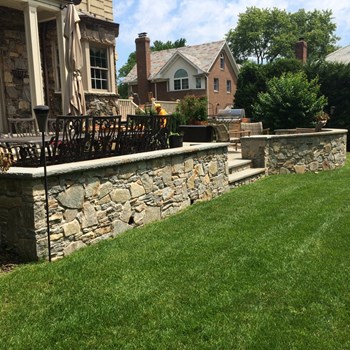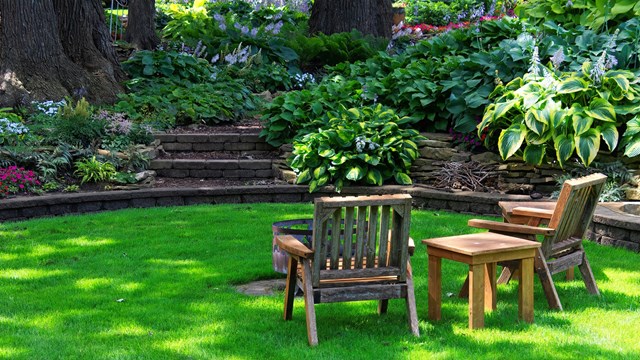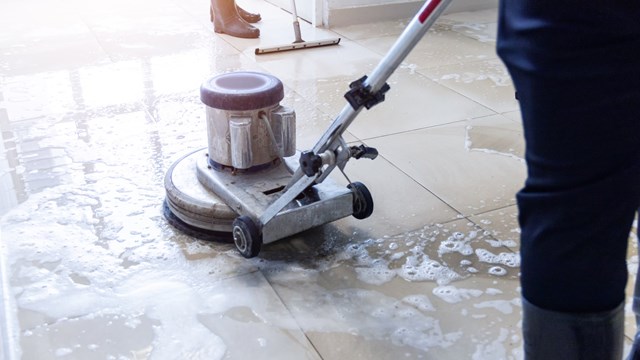
When most people think of landscaping, they think of shrubs, trees, meticulously laid-out and maintained flowerbeds, and artful plantings scattered around a building or development. However, landscaping doesn’t need to end with the things that grow.
What's Hardscaping?
“Hardscaping is any part of the landscape that’s not living,” says Jim Schimmenti, owner/operator of The Grounds Guys, a nationwide landscaping company, that has four locations in Illinois, and other Midwest offices in Indiana, Iowa, Michigan and Wisconsin. “So it’s the driveway, masonry, fencing, pergolas, patios, boulders and statues.”
Other hardscaping elements that can be used on the property may include stone retaining walls, concrete patios, brick and flagstone patios, stone walkways, gravel paths, stone landscape steps, wrought-iron fences, wooden fences and decks. Hardscaping may also help correct potential topographical problems with the property. For example, a fence or stone wall can function as a windbreak. Pavers can be installed where there is grass to create an amazing footpath. Other hardscape features, such as a fountain or a patio may be more for beauty, or to provide residents with a usable common area. An outdoor oasis can also be created around the community pool with walking paths, fountains, statues, rock gardens, terraces and wall elements.
“There are also more housing communities being built where there isn’t as much green space, but they need communal areas, and hardscaping is good for that,” says Schimmenti.
Smart Growth
Hardscaping is more than just plunking down a few rocks here and there, of course. “We keep the client’s needs in mind first, and from there we see what they want, come up with a concept that works within their budget and show them,” says Schimmenti.
As mentioned, hardscape elements can include everything from concrete to wood, flagstone and bluestone, bricks, and even metal. Because hardscaping elements are not alive, so they require no water, mowing, pruning or sun. On the other hand, landscaping can also turn brown over time and suffer from the effects of extreme heat or drought. There are other benefits to hardscaping, including the reduction of erosion and the opportunity for saving money from using elements already on the property and saving money on watering and landscape care. Instead of a yard that is purely green (although that is beautiful in its own right), hardscaping also provides depth and dimension to the landscape.
Anything that is on a hard surface outdoors counts as a hardscape—so the name has everything to do with the definition of the term, explains Heath Frey, a residential and landscape sales manager with Hirsch Brick and Stone, a masonry construction company in Park City, Illinois, specializing in custom construction of patios, pool decks, driveways, seat walls and columns.
“Hardscaping is an all-encompassing word for all the hard surfaces out in your lot or property,” Frey says. This ranges from the sidewalks, the pavements, terraces, walls, steps—anything you can think of when it comes to the surface area. “In the past, you used to be able to differentiate the hardscape from the landscape because it was impossible to permeate a hardscape, but now there are pavers that allow water to permeate,” so the definition has evolved with technology, Frey, who has a degree in landscape architecture, says.
There are a wide variety of hardscaping materials and features to choose from for the property that make the area both functional and aesthetically pleasing. Schimmenti says that the current trend in hardscaping is fountain water features. “Statues are also trending now,” he says. “They can be a focal point into a certain area.”
Hardscaping can be reflected in a variety of applications, such as in the use of modern fabricated planters, tranquil fountains, built-in outdoor kitchens, or a simple paving system that creates a new way of experiencing the space. Materials and features can also be married to each other. For example, water features can be included in with outdoor patios, or a gazebo can be surrounded by the right trees and bushes.
Making it Work
Hardscaping comes with its own set of challenges and engineering considerations. For example, putting in a retaining wall, or laying paving stones over a large area, may have consequences in terms of drainage, erosion, or other long-term effects. “The biggest concern when you’re adding hardscaping—like pavers, for example—is permeable soil for storm water runoff,” says Brannon Seaman, owner of Seaman Hardscaping in Oxford, Pennsylvania. “Where is the water going? You need to maintain a certain amount of permeable surface so the land can absorb the water and, depending on the area, you may have to pay a storm water management fee.”
Storm water runoff needs to flow away from the property, so that the water doesn’t erode topsoil and cause other issues. That means that any landscaping elements—organic or not—likely to impact runoff have to be placed carefully. There are other concerns to take into account as well. For example, a metal bench will heat up in direct sunlight, and therefore should be placed so as not to turn into a branding iron on hot summer days. A painted wood bench won’t get hot, but might fade or chip over time if subjected to constant blazing sunlight.
Another concern is utilizing hardscaping on green roofs, an especially common practice in Chicago, which is known for its sustainable landscapes. According to an analysis conducted by the city several years ago, there are more than 509 vegetated roofs in the city of Chicago accounting for some 5,564,412 square feet of rooftop space, making the Windy City the leader in that category.
For green roofs, especially with this type of application, you generally have a mix of large hardscaped and landscaped areas. Weight loads are a key component that has to be taken into consideration. This can be accomplished by utilizing a mix of paving materials, lower soil depths and positioning major components over key structural locations, experts say. In some cases, large boulders and statues must be brought to, and installed at, the property by utilizing large cranes to get the materials onto the rooftops. Sometimes, this can make the logistics of the project a nightmare.
Harder Materials, Easier Upkeep
Not only are plant-free landscapes an interesting departure from the more traditional landscaping approach, but rocks and paving stones require far less maintenance. For example, stairs need to be repaired and statues may need to be painted and cleaned.
However, less does not mean none. “Many hardscape components also need maintenance and care and this should be a conversation back at the design-build process,” says one landscaping pro. “For example, you could build an elaborate arbor out of exotic wood and it will look awesome on day one, but that wood needs to be reconditioned over the years to keep its luster going.”
Fountains and ponds need to be cleaned of algae on a regular basis to reduce the risk of buildup. “We have a service masonry cleanup once a year where we will powerwash and remove the sediment from any brick,” says Schimmenti. “It just helps the look of brick and keeps it clean. You can also seal the stone and put sealant on certain objects.”
Licensing?
Broadly speaking, there are no special licenses or credentials needed to do hardscaping, Frey says, though in Illinois, many municipalities do require a license to work in that area—so as with any other contractor, condo administrators need to check with the village or city hall prior to starting the job. Many townhome or condo complexes also have their own regulations regarding how capital improvement projects must be handled, so any drawings will need to be approved by the association board before moving onto the next stage. But aside from that, there is no greater authority looking over the work of hardscape contractors.
Since no formal credentials are needed, anyone from veteran landscapers to someone who has no businesses doing hardscaping may offer their services to a condo or HOA community. But hardscaping experts suggest that because of all the things that can potentially complicate a hardscaping project, you should do your due diligence—and they strongly suggest only hiring someone with specific hardscaping experience.
Most times, says Seaman, hardscaping projects are done by a certified landscape architect or a combination of a landscape architect and a landscaper. It is a specialty profession. Individual companies and associations also offer certification courses to teach the professional installer how to fit them properly. For example, the Interlocking Concrete Pavement Institute has an ICPI Concrete Paver Installer Certification course for installers. “The home improvement contractor does have to be licensed too.”
An engineer might also be called for, according to Seaman. For walls, typically anything over four feet needs to be engineered. “There needs to be proper support so it doesn’t collapse,” he says.
Schimmenti says projects vary in scope and difficulty. “They can vary in scope from large co-op courtyards to elaborate rooftop gardens all within the same building,” he says. “I think the real win-win for a client is having the advantage of a firm that can do both and understand how the two affect one another. For clients, working with a design-build firm that has knowledgeable staff that understands the relationship of how the landscape and hardscape are integrated produces a more seamless environment and one that generally reflects the intended project budget and clients expectations.”
The best landscape has a combination of soft and hardscapes that take advantage of the topography, location and needs of the property.
Lisa Iannucci is a freelance writer and a frequent contributor to The Chicagoland Cooperator. Managing editor Debra A. Estock contributed to this article.









Leave a Comment